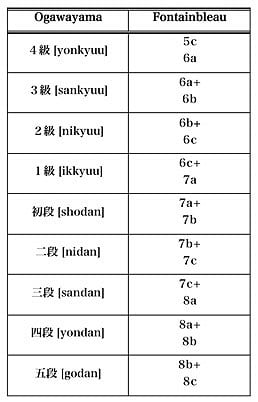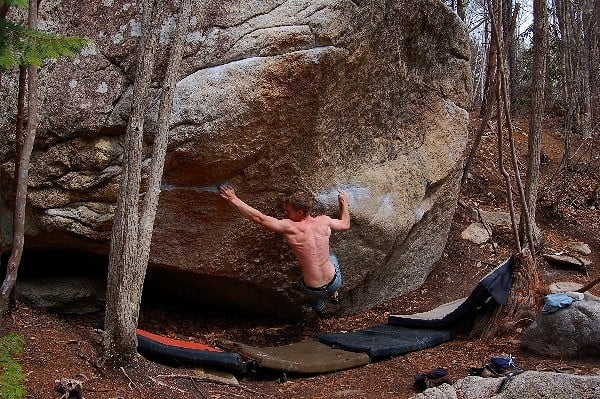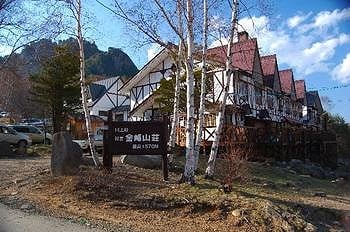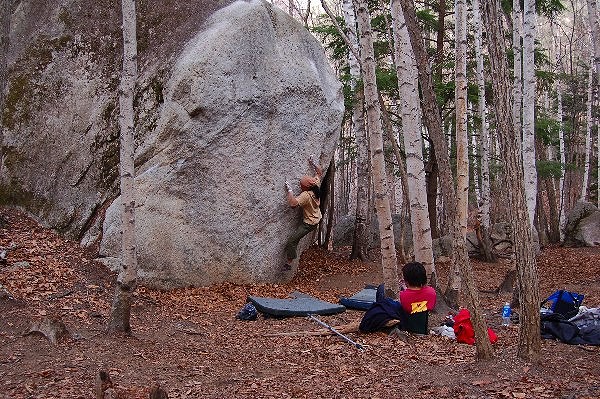Wedged between the mountains near the border of the Nagano and Yamanashi prefectures, in a valley whose name I have forgotten, is a village named after a tributary stream flowing by - Kawakamimura, or "Upstream village". If you ever pass this village and head up the mountains on the southern side, you will arrive at the gates of a campsite. Mawarime Daira or "Panorama Plateau" is surrounded by breathtakingly beautiful mountains, the most westerly of these are known as Ogawayama.
Ogawayama is the Camp 4 of Japanese climbing, a magnet for climbers and hikers from all over Japan. Around the campsite, rockfaces and big granite boulders are laid out before you everywere you look. Even if there aren't exactly any walls of the same magnitude as Half Dome or El Cap, there are routes of up to nine broken pitches - rather rare in a country where regular earthquakes give tall things a hard time.
The routes are not generally bolted, except where natural protection is impossible to arrange. So, if you want to do routes, bring natural pro. Some of these routes are truly majestic and perched in fantastic locations up on the steep forested mountains surrounding the valley. Unfortunately, I left my stoppers and friends in my parents' barn eight time zones west and bolted slabs are, well, not that interesting to me. No, it is the collection of fantastic boulders, conveniently spread around the camping site that entices me. Japan has quite a few spots with really good bouldering, but for pure beauty, Ogawayama might be hard to beat.
There are twenty one seperate bouldering areas described in the topo and all of them within walking distance from the campsite. About half of our time was spent at the blocks just above the parking lot. The heavily pocketed Kujiraiwa (Whale Boulder), one of the best single granite boulders I've ever seen, is located in that area. The problems on this block would feel just a little bit too high for a lot of people were it not for the perfectly flat landing beneath. I think it is fair to say that this area is the most popular area in Ogawayama, and on weekends it's pretty much like the boulders close to the car park at Bas Cuvier: you can go there without a crash pad, equipped with nothing but shoes and a friendly attitude. A bit further up the hill side there is another splendid area with some horrible hard slabs - among them the controversial Fukakai slab (Mystery Slab) which has two really hard problems - a 3-dan and an unprecedented 5-dan. Both of these look ace, if blank granite is your thing. The easier of these looks like it receives a fair bit of attention. Along the mountain stream that flows by the campground, there is another very popular area and by the edge of the woods along the creek there are some lovely blocks though a bit smaller then the blocks in the upper areas.

Grading - The Japanese system for grading boulder problems originated in Ogawayama. It's based on the same principle as grading for the martial arts, so if you have flailed about with arms, legs, or sticks, all dressed up in a pyjamas you know how it goes: 10-ky? or j?ky? demands the least amount of skill. As your skill progresses you pass 9-ky?, 8-ky?, and down to 1-ky?. After that you reach shodan, the first dan, or literally the "first step". This is where you get a black belt - and serious training is supposed to commence. In bouldering shodan starts around the 7a+/V7 mark, and it may be possible to reach the dizzying heights of the fifth step, godan, which is 8b+ to 8c on the Font scale. Or so I've been told. I've included my best guess on a conversion table, based on personal experience and input from my betters. Unfortunately, I've never been to Hueco, so I know nothing about V-grades, but the comparison with Fontainebleau is somewhat fair. This table doesn't really apply to all of Japan, since they are great fans of deflation.
As per usual for us grade-chasers of Nordic stock, when climbing in countries with shorter climbers, doing dynos is the top tip. The table is off for dynos compared to how they are graded in Fontainebleau, and just silly compared to areas where tall people dwell. Likewise, since we don't particularly like to get humiliated, we do stay away from low sit-starts on small pockets.
The boulders in Ogawayama really lends themselves to bouldering in the 1 kyu - 2 dan span (6c+ to 7c), with the majority of the really strong lines in this difficulty range. If this is what you prefer, you have a lot of first class problems to choose from, both high and low, enough for more than a week of climbing. There are quite a lot of quality stuff easier than this too. It is not like I tried anything harder than 2 dan anyway, but from the look of things I would guess that there are not more than perhaps two handfuls of high quality problems in the 3 dan and up range. People cruising 3 dan would probably like to go and wreck their tendons pulling down on shallow monos in Horai after making short work of everything in Ogawayama.
When to go - The mountains of Nagano prefecture have proper winters, so the climbing season in Ogawayama starts in early April and ends in late October. April-May and September-October have the best conditions, but autumn is way dryer. June is rainy season.In early May, even though you should expect temperatures below freezing during the nights, the temperature may rise to around 25C during the day, and at least in my imagination the cold mountain creek may cool off the temperature somewhat.
Getting there - You can fly to a number of airports in Japan, and depending on what kind of deal you get on the fare, you might go to Nagoya (Centair) or Tokyo (Narita). In my opinion though, anyone who goes to Japan without visiting the worlds largest metropolitan area is as mad as a hatter. Hence, go to Tokyo, stay there for a few days on the way in or out, and see what the future will look like. Mitake is also a good bouldering area with problems up to Fb 8b+ or so, within a short walking distance from the Mitake train station which in turn can easily be reached from Tokyo by regular commuting trains in less than two hours. It is possible to go to Ogawayama by a combination of trains, bus and a 35 min. hike. The closest train station is Shinano Kawakami on the JR Koumi-line, after that you're on your own, as I have no clue how to proceed.
My suggestion is to rent a car – those with yellow plates have ridiculously weak engines but are dirt cheap. That way you can easily get to Nana's "Super Convenience Store" to stock up on food and other necessities. It is easy enough to navigate the highways, but figure in some extra time for getting on and off them. A few days before the start of Golden Week, the Japanese equivalent to the occidental Eastern holidays, I tried to leave my apartment in downtown Nagoyaand head northwards toward Ogawayama. It didn't particularly help that my co-driver was jumpy, wary of my driving, dead tired, magnificently hungover, and had even less sense of direction than I have. The drive takes about five hours, from Narita airport north of Tokyo, to Ogawayama.

Staying there - For the high budget traveller I would definitely recommend staying at the ryokan. The rooms are in classic Japanese style, i.e. tatami mat covered rooms, without any wussy stuff like furniture. Japanese style breakfast and dinner are also included, and the food is excellent, as it tends to be in every ryokan. You might be surprised about what they serve for breakfast, but I guarantee you won't leave the breakfast table hungry. Book a room through http://w2.avis.ne.jp/~mawarime/ (Just showing up is bad form, I'm afraid.) Someone at the front-desk might be able to speak a little English if you're lucky. I've been told that they also may be able to pick you up at the train station.
For ¥700 (£3) pppn, you may pitch as many tents as you like wherever you want in the park but since people from Tokyo appear have no concept of personal space, the tents are packed closely together during holidays. The day golden week started, I was woken at 3am as people, leaving the cities after work the evening before, started to arrive in great numbers. When I got up later that morning, the campground had gone from a few tents strewn over the "Panorama Plateau" to a megacity of shiny new tents and canopies densely packed on the campsite.
We, like most people, choose to put up our tents as close as possible to the Ryokan, the luxurious Japanese-style mountain-lodge, since all facilities are centred around it: toilets, showers, a small shop, and of course, the ever present vending machines for tea, beer, coffee and cigarettes. People tell me that there is even a vending machine at the top of Mount Fuji. Not that I plan to ever slog up that volcano to get a can of lukewarm coffee...

In general, credit cards are not accepted in the countryside. Come loaded with cash; Japan is safe, no one is planning to rob you. It is not allowed, you see. Let me give you an example: every year more than 10 million pound sterling in cash is brought into the Tokyo police lost-and-found departments.
Culture - Japan is not Europe, nor is it the U.S., and if you don't have any special interest in things Japanese, you are not going to have a clue how to behave. Of course, foreigners are given some slack in the manners department, but it is nice not to behave outrageously gross, like blowing your nose in public, wearing shoes indoors, or eating on the go. Get a guidebook on Japan and read up on customs beforehand.
At the risk of generalising, there is something about Japanese culture that values dedication. Dedication to work. Dedication to play. Just witness the overworked salaryman sleeping his drunken stupor off, lying on a bench covered in his own vomit, waiting for the morning train, and you will understand what dedication to work and play is. Most boulderers you'll meet will be quite focused too, eh, on bouldering that is. If you want to keep up with them, expect hard sessions among the blocks.
Guidebooks - Your choices are basically:
- Nihon no Iwaba no. 3 by Kitayama Makoto - ISBN: 4635180131 - a part of a five book series that covers 100 areas in Japan. Most routes and some of the bouldering in Ogawayama are covered. You may order this book through amazon.jp (http://www.amazon.co.jp/gp/product/4635180131/)
- Ogawayama, Mitake, Mitsumine boulder book, by Tokio Muroi - easily recognisable by its dark cover, is the one to get for bouldering. It also also covers the areas Mitake and Mitsumine. There are no access maps though.
The drawings in both books are amazingly well done, and it is no problem whatsoever to use them without being able to read Japanese. If your interested in doing routes, there is an English topo on ex-pat Neil Harrison's excellent web-page, ogawayama.com, but for bouldering you need to get a Japanese guidebook.
The shop at Ogawayama stocks both of these guidebooks, but if you would like to order them before coming you can get them through http://www.pump-climbing.com/shop.htm

Language - Travelling in Japan makes anyone of sufficient age nostalgic. It certainly makes me remember the days when you couldn't get by in southern Europe without speaking the local language. Outside big metropolitan areas, do not expect people to understand English. At all. Use a phrase book, body language, pen and paper, speak slowly and carefully, and you'll do just fine.
Despite what you've might have been told, it is quite possible to say "you" in Japanese, just a bit complicated. "You" is "anata", but is very unnatural to say, so people go to great lengths to avoid using it. In fact, if you don't have a middle aged Japanese wife, I'll doubt anyone is ever going to address "anata". The most polite way to address someone is to use their title or name, with appropriate suffix, usually -san–but you lot may call me Jonas-sensei in deference to my significant amount of wisdom–, the second most polite way is to use nothing at all, and the least polite way is to use a pronoun, of which the Japanese language have at least six, depending on how assuming, or offensive, you want to be. So, whenever someone wants to strike up a conversation with you they might invent a title for you–like Mr. Uncle if you are older then their parents–or why not Gajin-san, Mr. Foreigner? Well-brought-up people will ask around for your name and memorise it when you are out of earshot, so that they can address you properly. I'm still not used to being called by name from people I have never met before though. It's feels almost like being famous, I suppose.
The reason I've included some direct links to webpages, even if they soon may be outdated, is that without being able to write Japanese it is very hard to find information using internet search engines. Japanese webpages have a tendency to be written in Japanese, with Japanese kana, you see.
Luckily, English is usually fine for sharing beta, since most relevant bouldering terms are borrowed from English. However, the names for big features are of Japanese, or sometimes German, origin.

Handy words/phrases
iwa - rock, boulder, cliff
hidari - left
migi - right
te - hand
ashi - foot/leg
kante - arête
Handy Excuses
muri - impossible
kowai - scary
abunai - dangerous
semai - narrow, bunched up
tooi - far, reachy
shimetta - damp, moist
futsukayoi - hungover
Words of encouragement
gamba - go for it! Allez!
oshii - almost, but not quite

Comments